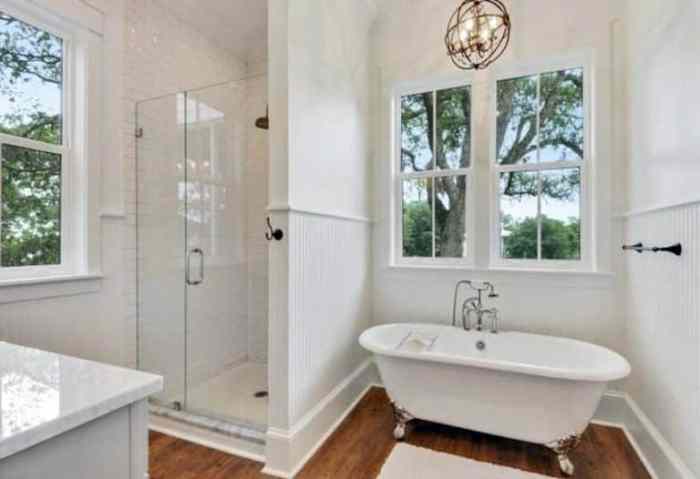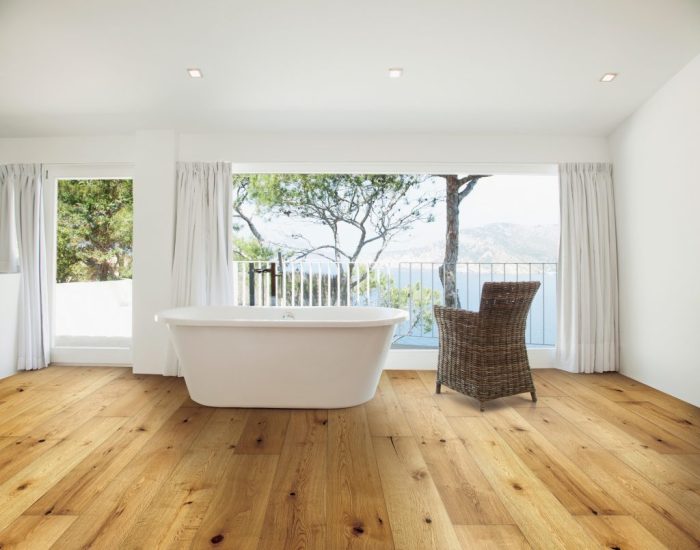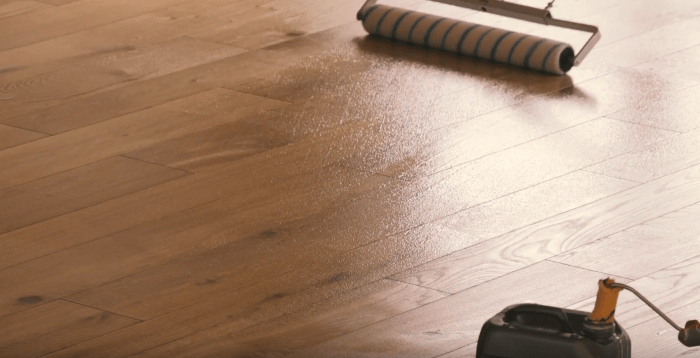Transform your bathroom into an oasis of both style and functionality with waterproof wood flooring. Unlike traditional wood, waterproof flooring offers the exquisite aesthetics of natural wood while providing exceptional protection against moisture and humidity, making it the ideal choice for bathrooms and other moisture-prone areas.
In this comprehensive guide, we will delve into the essential steps and techniques to waterproof your wood flooring, ensuring its longevity and beauty for years to come.
Embark on this journey with us as we explore the materials, preparation, application, and maintenance involved in waterproofing wood flooring. Whether you’re a seasoned DIY enthusiast or seeking professional assistance, this guide will empower you with the knowledge and confidence to create a bathroom that seamlessly blends elegance and durability.
Materials for Waterproofing Wood Flooring
To effectively waterproof wood flooring in bathrooms, a range of sealants and coatings are available. Each type offers unique advantages and drawbacks, so understanding their properties is crucial for making an informed decision.
Sealants
Sealants are liquid or paste-like substances that fill gaps and create a protective barrier on wood surfaces. They are typically applied to joints, edges, and other vulnerable areas to prevent water penetration.
- Polyurethane Sealants: Highly durable and flexible, providing excellent water resistance. However, they can be challenging to apply and may yellow over time.
- Silicone Sealants: Flexible and easy to apply, forming a waterproof bond. However, they may not adhere well to all wood surfaces and can be prone to cracking.
- Acrylic Sealants: Water-based and easy to clean up, offering good water resistance. However, they are less durable than polyurethane and silicone sealants.
Coatings
Coatings are applied to the entire surface of the wood flooring, creating a waterproof layer. They are typically available in various finishes, including matte, satin, and gloss.
- Polyurethane Coatings: Highly durable and water-resistant, providing a glossy or matte finish. However, they can be susceptible to scratches and may require reapplication over time.
- Epoxy Coatings: Extremely durable and waterproof, creating a high-gloss finish. However, they are more expensive and require professional application.
- Oil-Based Coatings: Penetrate deep into the wood, providing water resistance and a natural finish. However, they require regular maintenance and may not be suitable for high-traffic areas.
| Feature | Polyurethane Sealant | Silicone Sealant | Acrylic Sealant | Polyurethane Coating | Epoxy Coating | Oil-Based Coating |
|---|---|---|---|---|---|---|
| Durability | High | Medium | Low | High | Very High | Medium |
| Water Resistance | Excellent | Good | Good | Excellent | Excellent | Good |
| Flexibility | High | High | Medium | Medium | Low | Low |
| Ease of Application | Difficult | Easy | Easy | Moderate | Difficult | Easy |
| Finish | Glossy/Matte | N/A | N/A | Glossy/Matte | High-Gloss | Natural |
| Maintenance | Moderate | Low | Low | Moderate | High | Regular |
| Cost | Moderate | Low | Low | Moderate | High | Low |
Preparation for Waterproofing
Before applying any waterproofing products, it’s crucial to prepare the wood flooring properly. This involves several key steps to ensure optimal adhesion and effectiveness of the waterproofing treatment.
Cleaning and Drying
Thoroughly cleaning the floor is essential to remove any dirt, dust, or debris that could interfere with the waterproofing treatment. Use a mild cleaning solution and a mop or cloth to clean the floor, then allow it to dry completely before proceeding.
Repairs and Patching
Inspect the floor for any cracks, holes, or damaged areas that need to be repaired before waterproofing. Fill any gaps with a suitable wood filler or patching compound, allowing it to dry and cure according to the manufacturer’s instructions. Repairing these imperfections ensures a smooth and uniform surface for waterproofing.
Application of Waterproofing Sealant or Coating
Applying a waterproofing sealant or coating is crucial for protecting wood flooring in bathrooms from moisture damage. There are two main types of waterproofing products: sealants and coatings. Sealants are typically applied to joints and seams, while coatings are applied to the entire surface of the flooring.
Applying Waterproofing Sealant
- Clean the surface of the flooring thoroughly, removing any dirt or debris.
- Apply the sealant to the joints and seams using a caulk gun.
- Smooth the sealant using a putty knife or your finger.
- Allow the sealant to dry and cure according to the manufacturer’s instructions.
Applying Waterproofing Coating
- Apply a thin, even coat of the coating to the entire surface of the flooring using a brush, roller, or sprayer.
- Allow the coating to dry for the recommended time.
- Apply a second coat of the coating and allow it to dry completely.
The drying and curing time for waterproofing sealants and coatings can vary depending on the product. It’s important to follow the manufacturer’s instructions carefully to ensure the product performs as intended.
Maintenance and Care of Waterproofed Wood Flooring
Proper maintenance is crucial for preserving the longevity and appearance of waterproofed wood flooring. Regular cleaning removes dirt, debris, and spills that can damage the sealant or coating.
Cleaning Methods and Products
Use a soft-bristled broom or vacuum cleaner to remove loose debris. For wet cleaning, use a damp mop with a mild detergent specifically designed for wood floors. Avoid harsh chemicals, abrasive cleaners, or steam mops, as these can damage the sealant.
Preventing Damage
* Place mats or rugs under heavy furniture to prevent dents and scratches.
- Use felt pads on furniture legs to minimize wear.
- Wipe up spills immediately to prevent water penetration.
- Avoid excessive moisture, such as leaving wet towels on the floor or flooding the bathroom.
- Maintain proper ventilation to prevent moisture buildup.
Last Word
With proper care and maintenance, your waterproofed wood flooring will continue to enhance the beauty and functionality of your bathroom for years to come. Remember to clean regularly, using gentle cleaning methods and products designed for waterproofed wood flooring. By following these simple steps, you can protect your investment and enjoy the timeless charm of wood flooring in even the most moisture-prone areas of your home.
Embrace the beauty and practicality of waterproof wood flooring, and create a bathroom that is both stylish and resilient.



